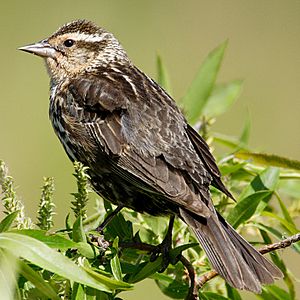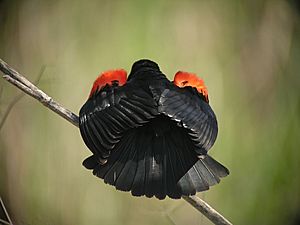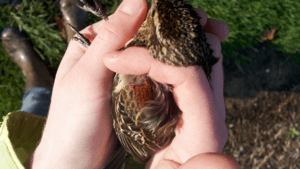Red-winged blackbird facts for kids
Quick facts for kids Red-winged blackbird |
|
|---|---|
 |
|
 |
|
| Female | |
| Conservation status | |
| Scientific classification | |
| Genus: |
Agelaius
|
| Species: |
phoeniceus
|
| Subspecies | |
|
A. p. aciculatus |
|
 |
|
| Range of A. phoeniceus Breeding range Wintering range Year-round range | |
| Synonyms | |
|
Oriolus phoeniceus Linnaeus, 1766 |
|
The red-winged blackbird (Agelaius phoeniceus) is a common bird found across most of North America and Central America. It lives in places from Alaska and Newfoundland all the way south to Florida, Mexico, and Guatemala. Some populations also live in El Salvador, Honduras, and Costa Rica.
These birds can spend winter as far north as Pennsylvania and British Columbia. However, many northern red-winged blackbirds migrate south to Mexico and the southern United States. They are thought to be one of the most common land birds in North America. Huge flocks, sometimes over a million birds, can be seen in winter. Scientists believe there might be more than 250 million breeding pairs in peak years.
Red-winged blackbirds look different depending on if they are male or female. This is called sexual dimorphism. Males are all black with bright red patches on their shoulders and a yellow stripe on their wings. Females are a plain dark brown. These birds mostly eat seeds and insects.
Contents
About the Red-winged Blackbird
The red-winged blackbird belongs to a group of birds called Icteridae. This family includes many different types of blackbirds found in North and South America.
The famous scientist Carl Linnaeus first described this bird in the 1700s. He called it Oriolus phoeniceus. Later, it was moved into the genus Agelaius with other American blackbirds. The name Agelaius comes from an Ancient Greek word meaning "belonging to a flock," which makes sense because these birds often gather in large groups. The word phoeniceus is Latin for "deep red," referring to the male's bright shoulder patches.
There are many different types, or subspecies, of red-winged blackbirds. Most of them look quite similar. However, two special groups, A. p. californicus from California and A. p. gubernator from central Mexico, look a bit different. For example, the females of A. p. gubernator are very dark brown with less streaking. Also, some male subspecies, like mailliardorum and californicus, do not have the yellow stripe on their wings that most other males have.
The Red-shouldered blackbird from Cuba used to be considered a type of red-winged blackbird. But now, scientists see it as its own separate species.
What do Red-winged Blackbirds Look Like?
The red-winged blackbird gets its name from the male's bright red shoulder patches. These patches are called epaulets and are easy to see when the bird flies or shows off. When resting, the male also has a pale yellow stripe on his wing. Younger males have smaller, more orange spots than adult males.
Female red-winged blackbirds are smaller than males. They are blackish-brown and lighter underneath. Females are about 17-18 cm (7 inches) long and weigh around 41.5 grams (1.5 ounces). Males are larger, about 22-24 cm (9 inches) long and weigh around 64 grams (2.3 ounces).
The female's upper body is brown, and her lower body has strong white and dark stripes. She also has a whitish stripe above her eye. Young females might have a salmon-pink spot on their shoulders. Older females usually have a more crimson (dark red) spot, similar to the males.
Both male and female red-winged blackbirds have a sharp, pointed beak. Their tail is medium-sized and rounded. Their eyes, beak, and feet are all black. Unlike many other North American songbirds, red-winged blackbirds don't get their full adult look until they are over a year old. Young males go through a stage where their wing spots are orange before they turn the deep red of adults.
Males are usually easy to spot, except in the far western United States. There, the tricolored blackbird lives, which looks very similar. Tricolored blackbird males have a darker red shoulder patch with a white edge, not yellow. It can be tricky to tell female tricolored, bicolored, and red-winged blackbirds apart where they live in the same areas.
Why are the Wing Spots Red and Yellow?
The bright red color of the wing spots comes from special red pigments called carotenoids. These are made by the birds themselves. However, yellow pigments from their diet are also found in the red feathers. This mix of colors is quite unusual!
If these red pigments are removed, the feathers turn a deep brown. This is because the feathers also contain dark pigments called melanin. The yellow stripes on the male's wings have a lot of melanin, even more than the red spots.
What are the Wing Spots For?
These colorful spots are very important for male red-winged blackbirds. They use them to defend their territory. Males with larger, brighter spots are better at chasing away other males. They are also more successful in fights.
Scientists did an experiment where they dyed the blackbirds' wing spots black. Many of these males lost their territories, while most males with natural spots kept theirs. This shows how important the spots are for showing strength to other males.
However, the size or color of the spots doesn't seem to help males attract females. This is different from many other birds where bright colors help find a mate. For red-winged blackbirds, the spots seem to be more about showing who's boss among the males. Females also have varying colors on their shoulder spots, which might show their strength in fights with other females.
Vocalizations
Red-winged blackbirds make several different sounds. Their calls include a low, throaty check and a high, slurred whistle that sounds like terrr-eeee.
The male's song is very famous. He sings a scratchy oak-a-lee while showing off his red shoulder patches. In some western birds, including the bicolored blackbird, the song is ooPREEEEEom. Females also sing, often a scolding chatter that sounds like chit chit chit chit chit chit cheer teer teer teerr.
Feather Molt
Birds replace their old feathers with new ones in a process called molting. For red-winged blackbirds, the most important molting time is from late August to early September. During this time, they might look a bit messy or "moth-eaten" because some feathers are missing. It can also make it harder for them to fly. Most red-winged blackbirds have almost finished molting by October.
Birds usually don't start their migration to warmer places for winter until their main flight feathers are mostly grown back. This means that molting, especially of the wing and tail feathers, is connected to when they start their fall migration.
How Feathers Change Over Time
- Young Bird Feathers (Juvenile plumage): When they are very young, both male and female blackbirds look similar to an adult female. Their shoulder spots might be brown and yellow.
- First Winter Feathers (First basic plumage): After their first molt, young males look black but have brown or beige edges on their feathers, making them look mottled. Their shoulder spot is usually orange with black specks. Females are dark with black and white stripes.
- First Breeding Feathers (First breeding plumage): By spring, the edges of the feathers wear off, making the males look dull black. Their orange wing spots might become more noticeable. Females look similar to their winter plumage but darker.
- Adult Winter Feathers (Second and subsequent basic plumages): After their second molt, adult males no longer look mottled. Their red wing spots become very bright scarlet. Females have crimson (dark red) wing spots and pink on their chin and throat.
- Adult Breeding Feathers (Adult bridal plumage): As spring arrives, the feather edges wear away, making the males' black feathers shiny. The wing spots on both males and females become even more intense in color.
Where Red-winged Blackbirds Live
The red-winged blackbird lives across almost all of North America. They avoid very dry deserts, high mountains, and dense forests. They breed from Alaska and Yukon in the northwest, and Newfoundland in the northeast, all the way down to northern Costa Rica. They live from the Atlantic to the Pacific coasts.
Birds that live in the northern parts of their range migrate south for the winter. They spend winters in the southern United States and Central America. This migration usually starts in September or October. However, populations in western and Central America generally stay in the same place all year.
Red-winged blackbirds prefer open, grassy areas. They especially love wetlands like freshwater and saltwater marshes, particularly if there are tall plants like cattails. You can also find them in dry areas like meadows, prairies, and old fields. In many places, they are the most common songbird in the swamps where they nest. They also live in farm fields and thin forests.
In the winter, these birds can gather in huge groups. For example, in Tennessee, a single roost (a place where birds sleep together) once held 11 million red-winged blackbirds! They often feed in cornfields and soybean fields.
Images for kids
-
A male red-winged blackbird mobbing an osprey (chasing it away).
-
A red-winged blackbird holding onto a rush plant in Point Pelee National Park.
See also
 In Spanish: Tordo sargento para niños
In Spanish: Tordo sargento para niños
















